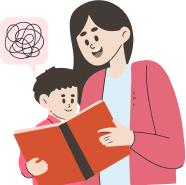Many kindergarteners struggle to shape their thoughts into stories, leaving parents unsure of how to guide them. The early stages of writing can feel messy, scattered, and frustrating.
This is where kindergarten story writing makes a difference. It provides children with a simple framework to express their ideas, build confidence, and enjoy the process of creating their own stories.
Research indicates that narrative skills at school entry predict writing and reading comprehension up to ten years later. Your child is at the ideal age to begin developing these foundational skills. With the right approach, story writing can become an exciting adventure rather than a challenging task.
This guide shares practical tips, techniques, and activities for kindergarten story writing to help your child gain confidence, overcome common challenges, and enjoy creating their own stories.
Key Takeaways
-
Story writing strengthens imagination, language skills, and early literacy in kindergarteners.
-
Structured steps and visual planning help children organize ideas and build confidence.
-
Creative techniques, such as props, games, and drawing, make writing engaging and enjoyable.
-
Regular practice with prompts, story starters, and collaborative projects develops storytelling skills.
-
Supportive guidance, encouragement, and celebrating effort foster long-term writing motivation.
Why Story Writing is Important for Kindergarteners?

Story writing plays a crucial role in your child's overall development during these formative years. Storytelling offers numerous psychological and educational benefits, including enhanced imagination to help visualize spoken words, improved vocabulary, and more refined communication skills.
Let’s look at the key ways story writing supports your kindergartener’s growth.
Cognitive Development Benefits
Your kindergartener's brain actively develops connections when creating stories. This process helps them:
-
Build vocabulary through exposure to new words and concepts.
-
Develop logical thinking by organizing ideas into sequences.
-
Strengthen memory skills by remembering story elements.
-
Practice problem-solving through character challenges.
Language and Literacy Foundation
Story writing creates a strong foundation for reading success. Children who write stories early show better understanding of:
-
Sentence structure and grammar patterns.
-
Beginning, middle, and end story organization.
-
Character development and plot progression.
-
Connection between spoken and written language.
Creative Expression and Confidence
Writing stories gives your child a voice to express their thoughts and feelings. This creative outlet helps them:
-
Build self-confidence through personal achievements.
-
Develop emotional intelligence by exploring different perspectives.
-
Practice self-expression in a safe environment.
-
Celebrate their unique ideas and imagination.
Now that you understand how story writing nurtures creativity, language, and confidence, let’s break the process down into simple, manageable steps your child can follow at home.
Also Read: Best Creative Writing Tools for Kids in 2025
Steps for Kindergarten Story Writing
Young children often have big imaginations but struggle to turn those ideas into structured stories. These steps are designed to bridge that gap, turning creative thoughts into organized writing that feels achievable for a kindergartener.
Here’s a simple, structured method to guide your kindergartener from an idea to a complete story.
Step 1: Choose a Topic Together
Start with subjects your child already loves and is familiar with. This familiarity reduces anxiety and sparks natural enthusiasm.
-
Ask about their favorite toys, pets, or family activities.
-
Use recent experiences, such as trips to the park or visits with grandparents.
-
Let them pick from a few options rather than completely open choices.
-
Connect topics to their current interests or recent books you have read together.
Step 2: Plan the Story Structure
Help your child understand that stories have a beginning, middle, and end. Keep this visual and straightforward.
-
Draw three boxes labelled "First," "Next," and "Last."
-
Have them draw simple pictures in each box showing what happens.
-
Talk through each part before writing begins.
-
Use familiar story patterns, such as "Once upon a time," for beginnings.
Step 3: Create the First Draft
Focus on getting ideas down without worrying about perfect spelling or handwriting. This reduces pressure and maintains creativity.
-
Let them draw pictures first if they prefer visual thinking.
-
Accept invented spelling and focus on their ideas.
-
Help with writing if their motor skills need support.
-
Keep sessions short to match their attention span.
Step 4: Share and Celebrate
Reading their story aloud helps them build pride and hear how their words sound together.
-
Read the story back to them with expression and enthusiasm.
-
Ask questions about their characters and plot choices.
-
Display their finished work in a special place in your home.
-
Share stories with family members who will respond positively.
After following the story writing steps, introducing fun techniques will keep your child motivated and turn writing exercises into a playful experience.
Also Read: How to Help Your Child Struggling with Writing Skills
Techniques to Make Story Writing Fun

Making story writing enjoyable keeps your kindergartener engaged and eager to continue developing their skills. Fun approaches remove the fear of making mistakes and encourage creative exploration.
The key is transforming writing from a chore into an exciting activity your child looks forward to doing with you.
Use Props and Costumes
Physical objects spark imagination and help children visualize their stories better.
-
Gather toy animals, dolls, or action figures as story characters.
-
Use dress-up clothes to help them act out different roles.
-
Create simple puppets with socks or paper bags for dialogue practice.
-
Set up story scenes with blocks, play food, or household items to create a narrative.
Make It a Game
Turn story elements into playful activities that feel less like traditional writing.
-
Roll the dice to determine how many characters appear in their story.
-
Use story cubes with pictures to generate random plot elements.
-
Play "What if" games to explore different story directions.
-
Create story chains where each person adds one sentence to the previous one.
Add Music and Movement
Incorporating physical activity helps kinesthetic learners engage more fully with the storytelling process.
-
Play background music that matches the story's mood.
-
Act out action scenes together before writing them down.
-
Use finger plays and hand motions for recurring story elements.
-
March around the room when characters go on adventures.
Digital Tools and Recording
Technology can make story creation more interactive and engaging for modern kindergarteners.
-
Record them telling their story first, then help write it down.
-
Use drawing apps on tablets to create story illustrations.
-
Take photos of their toys arranged as story scenes.
-
Make simple videos of them acting out their favorite parts.
Once your child is excited by fun techniques, you can reinforce their skills with practical activities that boost story writing fluency and turn it into regular, enjoyable practice.
Simple Activities to Help Your Kindergartener Write Stories

Regular practice with varied activities helps your kindergartener build story-writing skills naturally. These engaging exercises make writing feel like play rather than work.
Select activities that align with your child's current interests and energy level for optimal results.
Picture Prompt Adventures
Visual prompts give children immediate inspiration for their stories and reduce the challenge of starting from scratch.
-
Magazine Cut-Out Stories: Cut interesting pictures from magazines and have your child create stories about what they see happening.
-
Family Photo Tales: Use photos from family events and ask them to write about what happened before or after the picture was taken.
-
Illustration First: Let them draw a detailed picture first, then write a story explaining what is happening in their artwork.
-
Mystery Object Stories: Place an unusual household item in front of them and challenge them to create a story about how it got there.
Story Starter Sentences
Providing the first sentence removes the blank page anxiety while still giving them creative control over the story direction.
-
"The day I found a magic door in my backyard..."
-
"My stuffed animal came to life and said..."
-
"If I could fly anywhere in the world, I would..."
-
"The funniest thing happened when I was helping Mom cook..."
Character Creation Games
Developing interesting characters helps children understand story elements and creates personal investment in their writing.
-
Character Trading Cards: Draw pictures of made-up characters and write their names, ages, and special abilities.
-
Animal Personality Mix: Combine different animal traits to create unique story characters.
-
Superhero Workshop: Design superheroes with specific powers and the problems they solve.
-
Family Character Stories: Write stories where family members have special adventures or magical abilities.
Collaborative Writing Projects
Working together reduces pressure while modelling good writing practices and story structure.
-
Round-Robin Stories: Take turns writing one sentence each to build a story together.
-
Story Recipe Books: Create simple "recipes" for different types of stories with ingredients and steps.
-
Letter Stories: Write stories as letters to grandparents, cousins, or favorite book characters.
-
Season Chronicles: Keep an ongoing story journal about adventures throughout the school year.
Even with engaging activities, every young writer faces obstacles. Understanding common challenges and discovering practical tips to overcome them will help you guide your child without frustration or pressure.
Story Writing Challenges and Practical Solution Tips for Parents

Kindergarten story writing often breaks down at key points. Children may lose focus, struggle with spelling, or feel stuck in the middle of the process. Recognizing these hurdles will help you respond with patience and the right strategies.
Below are some common challenges parents face, along with possible solutions for each.
Challenge: "I Don't Know What to Write About"
When your child feels stuck for ideas, they need gentle guidance rather than complete creative freedom.
Solutions to Try:
-
Keep a family idea box filled with interesting pictures, objects, and story starters to inspire your creativity.
-
Start with "What if" questions about familiar situations from their daily life.
-
Use recent experiences, such as trips to the store or visits to the playground, as the foundation for your stories.
-
Read your favorite books together and ask how they would change the ending.
-
Create story maps of your house, school, or neighborhood to draw inspiration for your settings.
Challenge: Fear of Making Mistakes
Many kindergarteners worry about spelling, handwriting, or grammar instead of focusing on their creative ideas.
Solutions to Try:
-
Explain that first drafts are supposed to be messy and imperfect.
-
Show them examples of professional authors' rough drafts with cross-outs and changes.
-
Focus praise on their ideas and creativity rather than on technical accuracy.
-
Let them dictate stories to you while you write them down.
-
Use the phrase "invented spelling" to make errors feel more acceptable.
Challenge: Short Attention Spans
Kindergarteners naturally have limited focus, making longer writing sessions challenging and counterproductive.
Solutions to Try:
-
Keep writing sessions to a maximum of 10-15 minutes.
-
Break stories into small parts spread across multiple days.
-
Allow movement breaks between planning and writing phases.
-
Let them illustrate their stories when words feel too difficult.
-
End sessions while they still feel engaged rather than pushing through fatigue.
Challenge: Perfectionism and Frustration
Some children become upset when their writing does not match their mental vision of the story.
Solutions to Try:
-
Celebrate effort and progress rather than focusing on final products.
-
Share stories about famous authors who rewrote their work many times.
-
Maintain multiple versions to demonstrate how stories evolve through practice and refinement.
-
Focus on one story element at a time, rather than trying to tackle everything at once.
-
Remind them that every writer started as a beginner.
Challenge: Reluctance to Share Their Work
Children may feel shy about reading their stories aloud or showing their writing to others.
Solutions to Try:
-
Start by sharing with just one trusted family member.
-
Let them choose which stories they want to share and which ones to keep private.
-
Create a special family story time where everyone participates and shares their own stories.
-
Record them reading their stories if live performance feels too scary.
-
Display their work in private spaces before moving to public areas.
While you can support story writing at home, structured guidance can accelerate progress. FunFox Writers Club provides expert support, creative exercises, and a nurturing environment for young storytellers.
Also Read: 50 Creative Writing Exercises to Inspire Younger Writers
How FunFox Supports Young Story Writers?

Story writing can feel tricky for young children. FunFox turns it into an adventure they look forward to. Our specialized approach addresses the unique needs of young learners while laying a strong foundation for writing.
To make the most of story writing, FunFox combines structured guidance with playful strategies that support learning at every step.
-
Small Classes, Big Attention – With only six students per class, teachers can give personal guidance and celebrate every achievement.
-
Learning Through Play – Games, genre exploration, and vocabulary activities make writing an exciting and memorable experience.
-
Support Beyond the Lesson – Recordings, interactive worksheets, and parent-teacher check-ins help learning continue outside of the classroom.
-
Confidence Through Community – Sharing stories with peers fosters communication, teamwork, and a sense of pride in their work.
-
Flexible and Accessible – Online sessions fit busy schedules, connect children worldwide, and offer catch-up options when needed.
The FunFox Writers Club provides your kindergartener with the tools, confidence, and community support necessary to become a successful storyteller. Our experienced teachers understand how to nurture young creativity while building essential literacy skills that will serve your child throughout their academic journey.
Conclusion
Kindergarten story writing lays the groundwork for imagination, language, and self-expression. By practicing regularly with engaging tips and techniques, your child gains confidence and builds essential persuasive writing skills.
Every young writer progresses at their own pace, and small, consistent steps matter more than perfection. Encouraging creativity, celebrating effort, and making writing enjoyable help children develop a lasting love for storytelling.
FunFox Writers Club offers structured guidance and creative support, transforming the writing of stories into an engaging learning experience.
Give your kindergartener the tools to become a confident storyteller. Book a trial class with FunFox today and watch their creativity flourish.
FAQ’s
1. How to write a story for kids step by step?
Start by choosing a familiar topic. Plan the beginning, middle, and end. Encourage drawing or dictating ideas. Guide your child through writing a draft, then read and celebrate the story.
2. What is the story structure for kindergarten?
Kindergarten stories follow a simple pattern: the beginning introduces characters and setting, the middle presents a problem or event, and the ending provides a solution or conclusion. Pictures and simple sentences support understanding.
3. How can parents help kindergarteners improve storytelling skills?
Encourage daily storytelling through prompts or picture-based activities. Discuss ideas before writing. Praise creativity and effort. Read stories together to model language patterns and narrative flow.
4. What are effective techniques to make story writing fun for kindergarteners?
Use props, puppets, and games to spark imagination. Incorporate drawing, acting, or music. Turn writing into a playful challenge to motivate engagement and creativity.
5. What are the five steps of writing a story?
Choose a topic, plan the story structure, create characters and setting, write a first draft, and share the story. Each step builds skills and confidence in young writers.















